
- Visiting New York
- Broadway Shows
- Bryant Park
- Central Park
- Empire State Building
- Free Things to Do
- Grand Central
- Historical New York
- Hudson Yards
- In the Spring
- In the Summer
- In the Winter
- Moving to New York City
- New York Botanical Gardens
- Rockefeller Center
- Subways (& their Stations)
- Times Square
- World Trade Center
- New York Diaries
Hanit Gyani


Old City Hall Subway Station in New York

The City Hall Subway Station is one of New York’s must stunning underground treasures, and it has been closed to the public since 1945. Actually visiting the abandoned City Hall Subway Station in New York is only permitted through tours organized by the New York Transit Museum, and the ticket for these tours is so prized that it has been recognized as being tougher to get than a a ticket for a Taylor Swift concert by NY Post. I was fortunate enough to score a ticket for one of these tours, and am thrilled to be among the few New Yorkers that have had the opportunity to visit what used one to the Jewel in the Crown of NYC’s subway stations.
The City Hall station is one of the original 28 subway stations of the New York City Subway. In keeping with the times when it opened, it has magnificent vaulted ceilings, stained glass skylights, tiles by Rafael Guastavino, who is the same tile maker as can be seen in Grand Central’s Whispering Gallery, chandeliers and a tightly curved track that loops around and is in use by the 6 subway line even today, despite the station being closed. This once-active station has transformed into an intriguing, hidden underground attraction that can be experienced by a lucky few on guided tours every year.
The City Hall Subway Station’s tightly curved platform, which was built to accommodate the shorter train cars that existed when it was built in 1904, leaves large gaps between the train and the platform for the longer subway cars that have become the norm, causing it to be closed down in 1945.

Table of Contents
History of old city hall station.
City Hall Station, located in lower Manhattan, was one of the first 28 subway stations that opened in New York City on October 27, 1904. It was part of the IRT Lexington line, and designed by Rafael Guastavino with his classic Guastavino tile that covers its high roof arches, which has survived its placement in an abandoned station and looks magnificent even today.
The City Hall Subway Station was very unlike the other stations with its elegant Romanesque Revival architectural style with a ceiling which consists of twelve Guastavino vaults, made of white tiles with green and brown tiles along the perimeter of each vault. Three of the vaults have leaded glass skylights that opened upward to vault lights in City Hall Park, which are slowly but surely coming apart as time goes on. Additional lighting was provided by twelve chandeliers hung from the center of the vaults, with floral motifs and nickel finishes, with exposed bulbs to showcase electricity, which was very much the fashion of the time as can be seen in the Grand Central chandeliers as well. The chandeliers near the skylights have five arms, while the others have four.

The very first subway ride in New York City commenced from City Hall Subway Station, kicking off what has become the lifeline of New York City. The station operated until 1945, when it had to be closed down as longer length of the newer subway cars meant the doors would open too far from the curved platform, making it unsafe for passengers to enter and exit the trains. The last City Hall train ran through this station on December 31, 1945.
City Hall Station has been recognized for its historical and architectural value, eventually acquiring landmark status in 1979. It truly is a throwback to the gilded age in New York, which can now only be accessed through tours organized by the New York Transit Museum.
Visiting City Hall Subway Station
The only way to visit the City Hall Station is through tours organized by the New York Transit Museum. Tickets are only available to members of the Museum, and the number of people covered in your membership can try to buy tickets to the City Hall Station tours. For instance, I signed up for a single membership, and that allowed me to buy one ticket for the City Hall Station tour.
Buying Tickets
Buying a ticket for the City Hall Subway Station Tour is a little bit more complicated than just being eligible for one. New York Transit Museum offers tickets for sale to their members three times a year at specified times for $50 a ticket for visitors 10 and older. You have to log in through your account, through very specific links that are emailed ahead of time, and be ready to hit the buy button as soon as the tickets go on sale as they sell out in minutes. I had to reset my password, which made me miss the first set of tickets I tried for, and then was ready for the second lot but did not go in through the designated links and missed out this chance as well. Third time was luckily the charm for me, and the stars aligned as I could get a ticket that was 3 months away.
The tickets are only intended for the members or names they specify as guests while buying them. Within 48 hours of buying your ticket, you need to email in your ID for a background check, and carry the same ID when you go for your tour. The tickets are not assignable, and the amount you paid is considered a donation if the person cannot make it for any reason at all. Our IDs were checked before the tour, so this is closely managed. This makes it impossible to buy a ticket second hand, or even to sell it as the hottest ticket in NYC.

There is a way to catch a sneak peek of the station by hiding on the downtown 6 subway train past its last stop, and catching a glimpse of the City Hall Subway Station as it loops around through the Abandoned City Hall Station to the other side of the track. After having visited the station through one of the New York Transit Museum tours, the sneak peek – which we got as we had to use the 6 train to enter and exit the station – is a very sad consolation prize indeed!
Here is a video of what the station looks like when viewed from the inside of a subway train, I took it on our way in and out of the station.
However, it is only a fraction of what you can see of the station from the platform as you can see in this video I took of a 6 subway train passing through the station while we were on the platform as part of the tour.
City Hall Subway Station Tour
The City Hall Subway Station Tours run for 90 minutes, though it can take months of planning to actually get to the point of attending one. It starts at Broadway and Warren Street, just inside the City Hall Park.
The City Hall Subway Station tour is a walking one, and visitors must be able to walk and navigate stairs to be able to attend. The guide communicates with everyone in the tour through headsets that are provided for use, which work well over and under ground. The guide, ours was Kristen, was very friendly, introduced herself to everyone before the tour, and was very knowledgeable and engaged in the 90 minutes we were on the tour.
The tour starts above ground, where we learnt about the history of the subway system and the areas around City Hall. We were shown the location of the original entrance to and the skylights we were going to experience in the City Hall Subway Station above ground, before we made our way to the downtown 6 track in the current Brooklyn Bridge-City Hall Station.

We got on the first train car of a downtown 6 train, which actually stopped at the City Hall Subway Station where a ramp had to be put up for us to enter the station. The guide walked us through the history of the station, and then gave us 10-15 minutes – it is easy to lose track underground – and then we caught a 6 train, which stopped especially for our tour at the station, back to the uptown 6 train station.

Old City Hall Subway Station
The City Hall Station, designed by Rafael Guastavino, is an architectural masterpiece featuring intricate details and elegant designs that are reflective of the gilded age it was built in. Its skylights that allow sunlight to filter into the space and its vaulted ceilings are unexpected in a subway station.
The architecture of the station features a series of Guastavino’s signature vaulted ceilings, which are embellished with ornamental tiles and patterns.

It is sad to see the skylights on the platform falling into disrepair with the station being abandoned, though their grandeur still shines through all the same. The location of these skylights was pointed out to us above ground at the start of the tour.

The City Hall Subway Station’s curved platform was designed to hug the train’s exterior, providing a seamless transition for passengers boarding and alighting. However, this platform did not work well with the newer, longer trains, making this unique design a disadvantage, eventually leading to the station’s closure.

Closing Thoughts
The Old City Hall Subway Station continues to be a jewel in New York’s crown, despite having been closed since 1945. Visiting it is out of reach for everyone except if you are lucky enough to score a ticket on a New York Transit Museum tour. The tickets are not transferable, and the only way you can get one is by becoming a member of the museum. It takes a lot of planning to visit, and is entirely worth the effort.
November 19, 2023
Historical New York Subways (& their Stations)
Previous Longchamp x Robert Indiana collaboration for the Classic Le Pliage Bag
Next dior’s carousel of dreams: 2023 saks holiday light show, hanit gyani author posts.
Hi, I'm Hanit Gyani, a full time professional by day and a blogger by night and weekend. Welcome to my blog, aka my passion project, Gotta Love New York.
Related Posts ...

Muhammad Ali Room at the New Yorker Hotel

Loew’s Paradise Theater in the Bronx

The Original New Yorker Hotel: A Historic Icon in Midtown Manhattan
Comments are disabled.

Discover Top Things to Do in New York City
How to Visit NYC’s Abandoned Old City Hall Subway Station
Old city hall station is a secret hidden subway station in new york city.
A look inside the Hidden Subway Station in NYC , which has been shuttered since 1945. Old City Hall Station is of the most architecturally stunning subway stations (by master artisan Rafael Guastavino) you’ve most likely never stepped foot in.
The City Hall Station was the original southern terminus of the first “Manhattan Main Line” built by the Interborough Rapid Transit (IRT) Company. The line, opened in 1904, was intended to be a showpiece and crown jewel of the new subway system. Unlike the rest of the line, City Hall featured tall tile arches, brass fixtures, and skylights that ran along the entire curve of the station — a sort of miniature Grand Central Station. In fact, befitting the elegance of the station, it was even the chosen place for hanging the commemorative plaques recognizing the achievement of building the underground train system.
How to visit the abandoned Old City Hall Station
The station is at the end of the 6 train line which terminates at the “Brooklyn Bridge/City Hall Station” in Lower Manhattan. It is located beneath the magnificent Municipal Building at the intersection of Centre Street and Chambers Street. Because the downtown-bound 6 train must make a U-turn to head back uptown, the train makes a loop through this secret station. Here’s how to see it:
- Take the 6 train heading downtown.
- When the train makes its final stop at the “Brooklyn Bridge/City Hall” station, passengers are told to exit the train.
- Stay on the train and duck down so as not to be easily spotted. When the train departs the station it will pass through the (Secret/Hidden) City Hall Station. That’s when you can get a view of the station – be discreet.
Keep in mind that staying on the train isn’t officially legal. But it appears that MTA no longer strictly enforces the announcement that passengers leave the train at the Brooklyn Bridge station. Secretly visiting the station is somewhere in the ‘grey’ area of legality.
Safety and security concerns are the main reasons why the MTA does not regularly open the space to the public.

Tours of the Station
Public tours have been offered by the New York Transit Museum about 16 times a year. Tickets cost $50 per person and sell out very quickly. If you want to experience the City Hall station, your best bet is to get a Transit Museum membership, which costs between $35 and $50 a year.
Old City Hall station tours begin above ground with a historical walk in the area, followed by a visit to the station itself. Tours last approximately 90 minutes from beginning to end, run rain or shine, and require walking, standing, and stair climbing
“ Some people spent the entire evening on the trains, going back and forth from 145th street to City Hall for hours. Reveling in the sheer novelty of the underground, these riders wanted to soak up its unfamiliar sights and sensations for as long as possible. ” (Clifton Hood, 722 Miles: The Building Of The Subways [ via Forgotten New York .])
Written by JULIAN MACIAS

CEO and Founder of New York City Feelings, Freelance Website Designer and Social Manager, I can make your online world rock. Contact me asap!
© 2024 NewYorkCityFeelings.com
Take A Guided Visit To The Hidden Ghost Station In NYC’s Subway System
Get exclusive access to NYC's most famous decommissioned subway station through the Transit Museum's tour of the old City Hall station.
Our century-old subway system (and the world’s largest!) is a quintessential part of NYC, and members of the New York Transit Museum will get exclusive access to explore it in all of its glory.
Returning to the museum are tours of the old City Hall subway station , the first-ever station of the New York City subway. Opened in 1904, it was intended to be the pièce de résistance of the entire transit system.
The tour begins above ground to discuss Alfred Beach’s Pneumatic Tube, before traveling deep underground to uncover all the secrets and fascinating history of our transit system and beyond . You’ll be able to explore spaces even the most seasoned commuter might not know about!
Though trains haven’t stopped at City Hall for years, the track remains active for a turnaround on the 6 line.
As you take a look around, you’ll be absolutely mesmerized by the beautiful architecture, with similarities of a cathedral design peeking through.

From vaulted ceilings, to brass chandeliers, there’s no station that’s quite as aesthetically pleasing as this one. It’s located just beneath the Municipal Building, in what used to be the epicenter of the city at that time.
You might be wondering why a perfectly good subway station isn’t in use anymore? As the years have passed and the trains have gotten bigger, the platform itself simply can’t accommodate the larger trains and the distance of the gap became unsafe for passengers entering and exiting.
As outlined on the New York Transit Museum website , tour registration is a two-step process:
- Become a member
- Provide a government-issued ID and sign a Visitor Release form within 48 hours of your tour purchase
Note: Tickets have been sold out for 2023. Additional tickets will be available come early 2024.
Learn more on the New York Transit Museum website here .
TYPE IN YOUR SEARCH AND PRESS ENTER
Here’s your chance to see NYC’s dazzling, abandoned City Hall station—without risking a criminal trespass charge
Tickets to see the city's first-ever subway station go on sale on April 17, and will sell out quickly
By Roadtrippers
In the late 1800s, New York City—with nearly a million people concentrated in lower Manhattan—was experiencing a horse manure crisis. The brick and cobblestone streets were choked with people, vendors, and horse-drawn streetcars, the latter of which produced 2.5 million pounds of manure every single day. It is estimated that if the horses had remained, Manhattan would have been buried under nine feet of equine excrement by 1930.
Anyone who has ever visited New York knows that, thankfully, this disgusting prophecy didn’t come true—even if it sometimes still smells as if it did—in part because of the advent of non-horse-reliant public transportation. Construction on the city’s subway system began in 1900, and on October 27, 1904, the first station opened beneath City Hall in lower Manhattan.
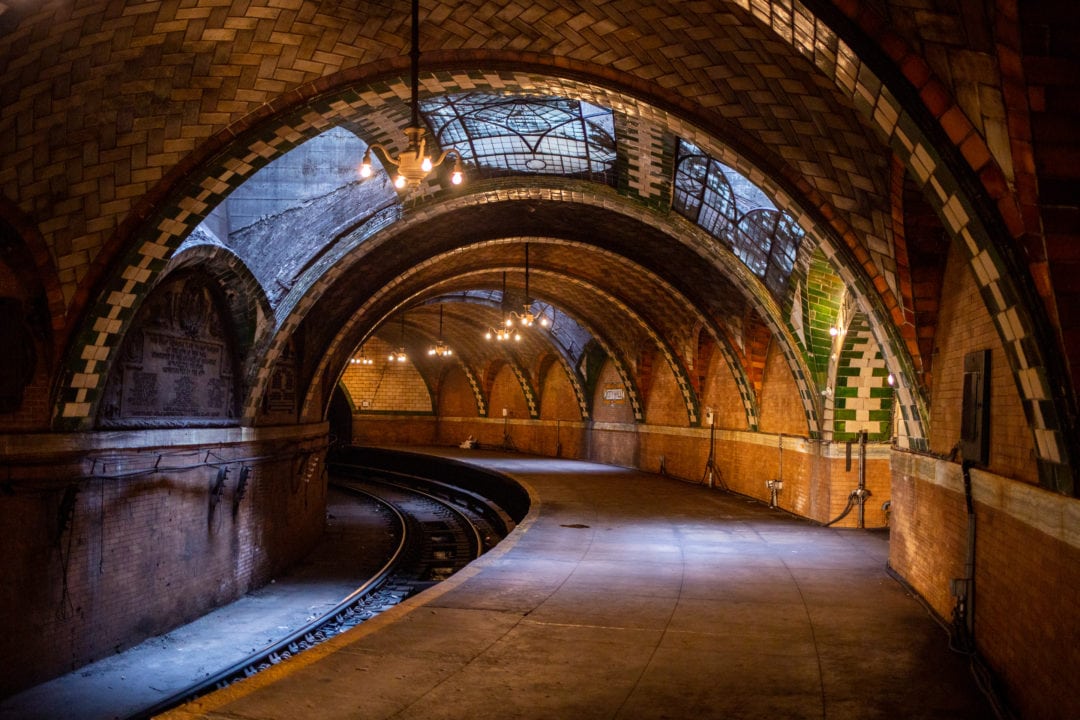
Today the old City Hall station—closed since 1945—is popular with urban explorers. If you want to avoid a criminal trespass charge , you can take a sanctioned tour , available only to members of the New York Transit Museum. But be warned: Tickets only go on sale three times a year and sell out quickly.
The next round of tickets goes on sale to members on April 17. It is “one of our most popular behind-the-scenes tours,” says Regina Asborno, deputy director of the New York Transit Museum.
Pneumatic tubes and a historic blizzard
Technically, the old City Hall station is New York City’s second “first” subway station. In 1870, Alfred Ely Beach—an inventor, publisher, and lawyer—designed the city’s first underground public transportation, which he called Beach Pneumatic Transit.
While the construction of the eight-foot-in-diameter tube was obvious, its purpose was not. Beach got permission from notoriously corrupt Tammany Hall to build a pneumatic mail tube, which, he claimed, would carry letters deposited in lampposts to the nearby post office.
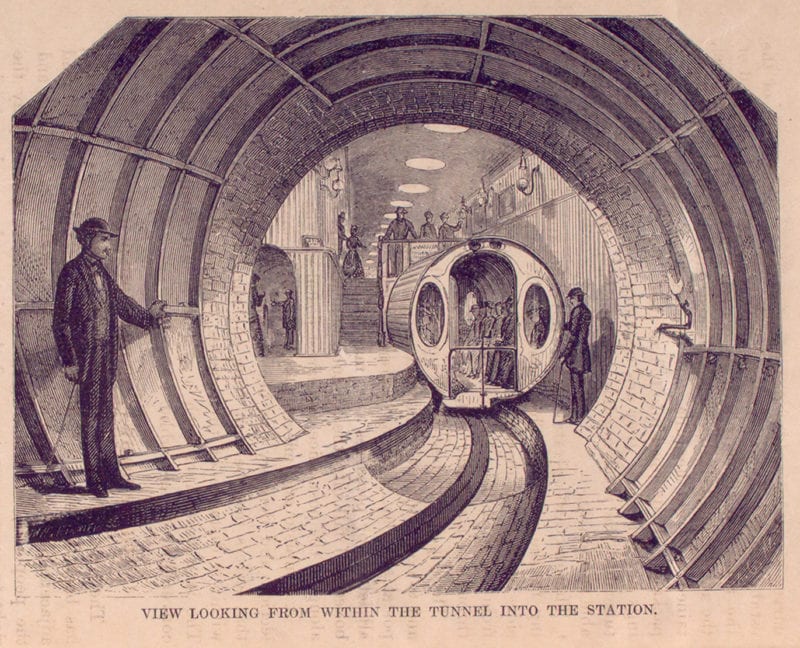
The tube, which took 58 days and $350,000 of Beach’s own money (about $6.2 million today) to construct, was actually conceived as the city’s first subway line. Passengers brave enough to try it out—and rich enough to afford the 25-cent fare—entered through a department store entrance, lavishly decorated with paintings, chandeliers, pianos, and fountains. One round, wooden car carried riders 312 feet under Broadway, from Warren Street to Murray Street and back again, blown by a gigantic fan.
Beach’s smooth, quiet, and comfortable prototype was a success—and proved that not only was underground transit possible, but it was popular. Beach lost his funding in the 1873 financial crisis and the tube was sealed, forgotten until 1912 when it was rediscovered by workers digging the R line. The tube and car were destroyed, but the public’s appetite for public transit was not.
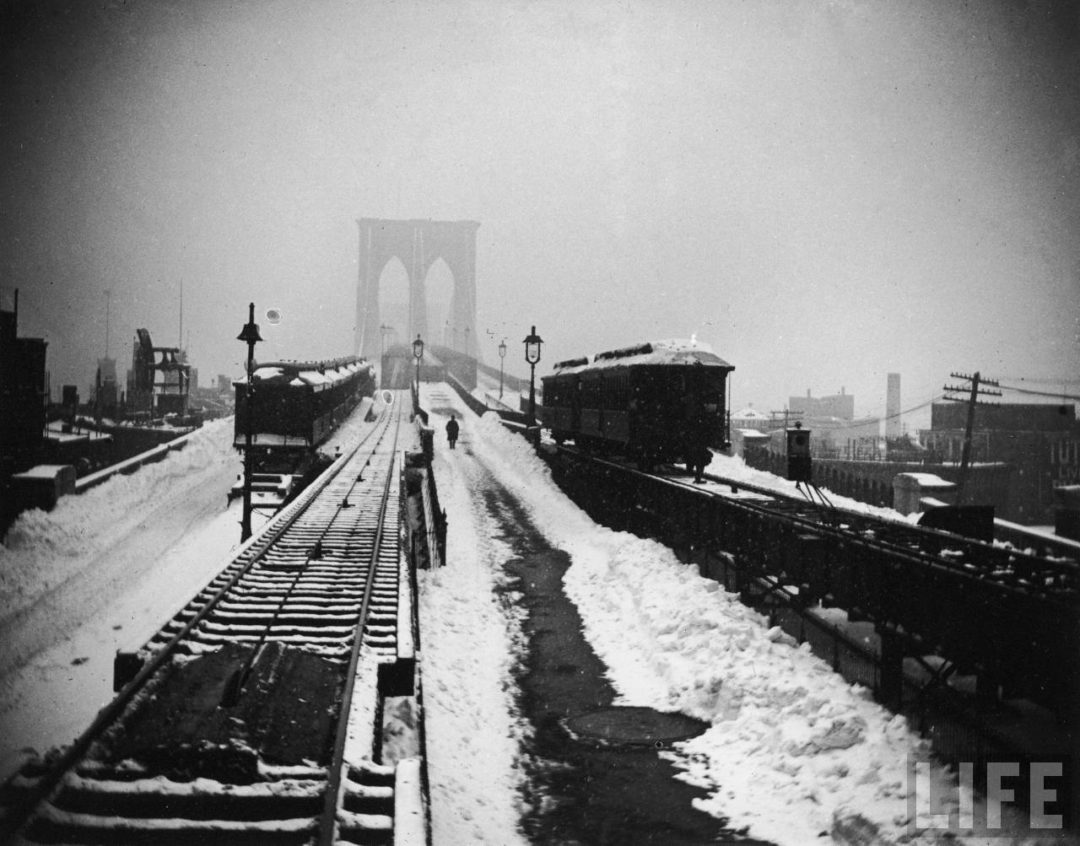
The first elevated railway in New York City opened in 1868, but the blizzard of 1888 exposed flaws in the outdoor, above-ground transit system. The storm dumped nearly two feet of snow and created drifts of up to 50 feet in a unprepared city, trapping 15,000 New Yorkers on elevated trains—some for up to 24 hours.
The Sanitation Department was formed to help clear the snow, power and communication lines were buried to prevent future damage, and on March 24, 1900, the privately-owned Interborough Rapid Transit (IRT) company began building the city’s second underground subway station.
The city goes ‘subway mad’
On the day it opened, 150,000 people passed through the old City Hall station, referred to as the “Jewel in the Crown” by the New York Transit Museum . By the end of the week, one million people had used the Romanesque-Revival station, which features brass fixtures, wrought iron chandeliers, three skylights, and Guastavino-tiled arches.
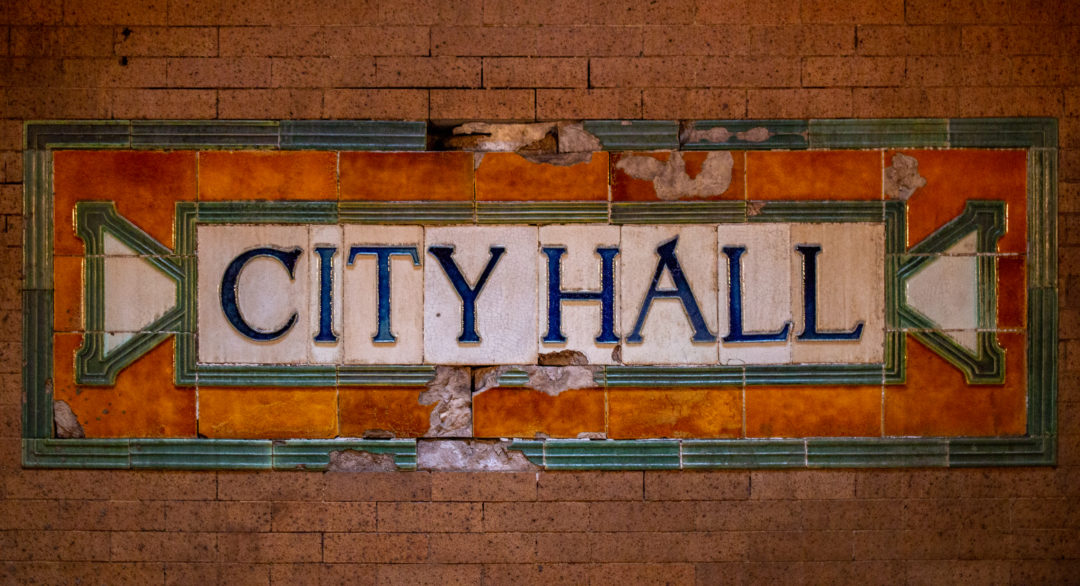
With Mayor George B. McClellan at the helm, the inaugural ride carried “silk-hated, frock-coated dignitaries” 9.1 miles through 28 stations—from City Hall to Grand Central Terminal, across 42nd Street to Times Square and then up Broadway to 145th Street.
“The other stations were utilitarian boxes that could not compare to City Hall’s,” writes Clifton Hood in his book 722 Miles: The Building of the Subways and How They Transformed New York .
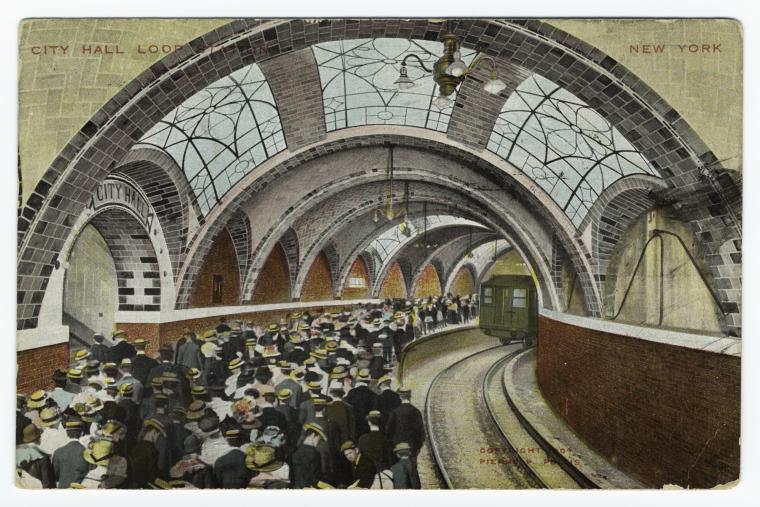
“New York City went ‘subway mad’ over the IRT’s inauguration,” Hood writes. “For the preceding few weeks, hundreds of New Yorkers held ‘subway parties’ to celebrate the big event. Church bells, guns, sirens, and horns resounded all day long.” Spectators gathered on a viaduct to watch the first train emerge from beneath the surface in uptown Manhattan.
“The sheer exuberance of opening night proved to be too much for others,” according to Hood. “Although they bought their green IRT tickets and entered the stations like everyone else, these timid passengers were so overwhelmed by their new surroundings they did not even attempt to board a train. All they could do was stand on the platform and gawk.”
City (Beautiful) Hall
The old City Hall station was designed as part of the City Beautiful movement , by architects Heins and LaFarge. Known for their work on churches, Heins and LaFarge worked on the Cathedral of St. John the Divine, and it’s not hard to see their influence in the City Hall station’s vaulted ceilings and leaded glass skylights. “The flagship station at City Hall was an underground chapel in the round,” writes Hood.
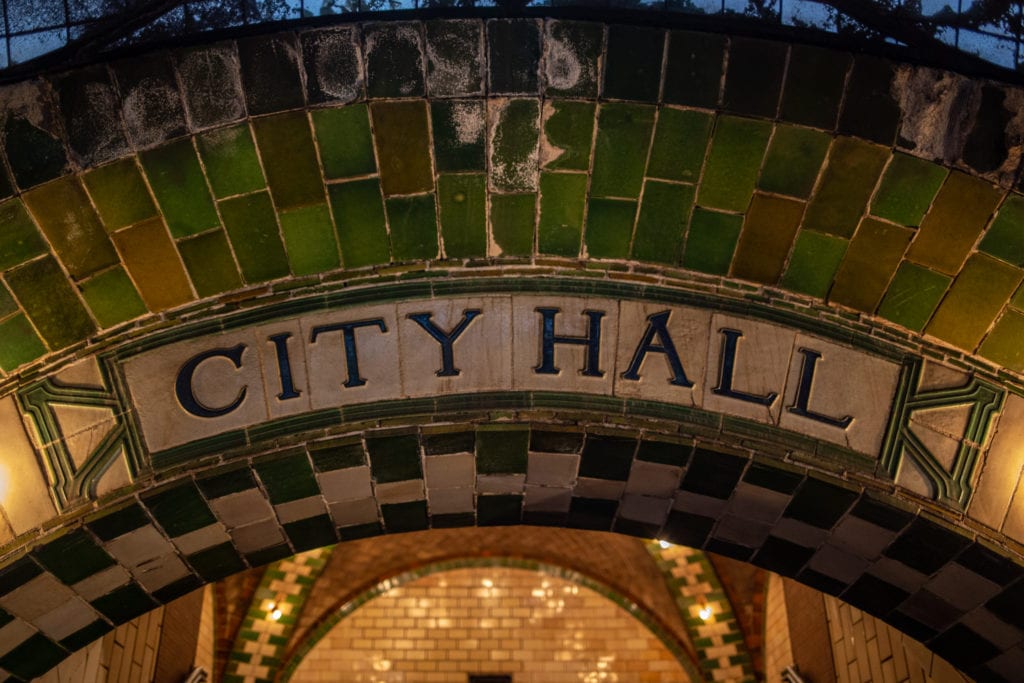
Customers purchased tickets from an elaborate oak ticket booth located on the mezzanine for five cents—the fare didn’t increase until 1948, when it doubled to ten cents. According to former New York Transit Museum educator and current tour guide Katherine Reeves, it didn’t take long for the close confines of the subway to attract crime. “The station wasn’t open fifteen minutes before someone was robbed,” she says.
The City Hall station follows a very sharp curve, necessary to help trains navigate the foundations of the City Hall Post Office and Courthouse, which was demolished in 1939, and City Hall itself. The station was built to accommodate five-car trains with doors on each end—the introduction of side doors in the 1940s exposed a cavernous, and potentially dangerous, gap between the curved platform and the train car doors.
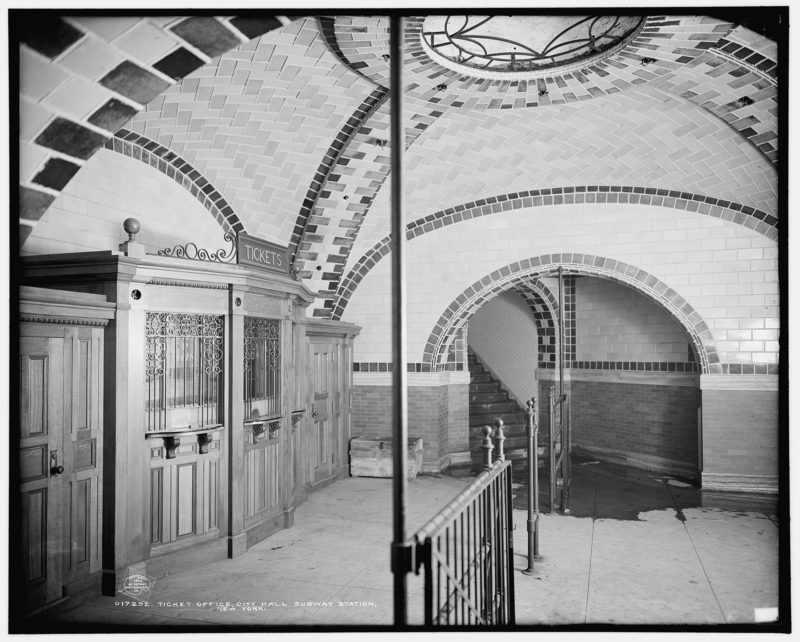
In 1940, the city bought the IRT and the Brooklyn Rapid Transit Company (later called the BMT), combining both lines with the city-owned Independent Subway System (IND). In 1953, the New York City Transit Authority (NYCTA) was created to control all subway, bus, and streetcar operations; in 1968 these entities were placed under control of the state-level Metropolitan Transportation Authority, known as the MTA.
After consolidating the three subway lines, the city began to root out redundancies in their newly-unified system. The local City Hall station’s proximity to the more popular express Brooklyn Bridge station meant that ridership had been steadily declining since it opened—in its final year, only 600 passengers per day passed beneath the City Hall station’s ornate arches and it was closed for good on December 31, 1945.
Abandoned but not forgotten
Although now commonly thought of as abandoned, the old City Hall station is still considered an active part of the subway system. No. 6 trains use the track as a turnaround, screeching around the sharp curve about every eight minutes or so, 24 hours a day.
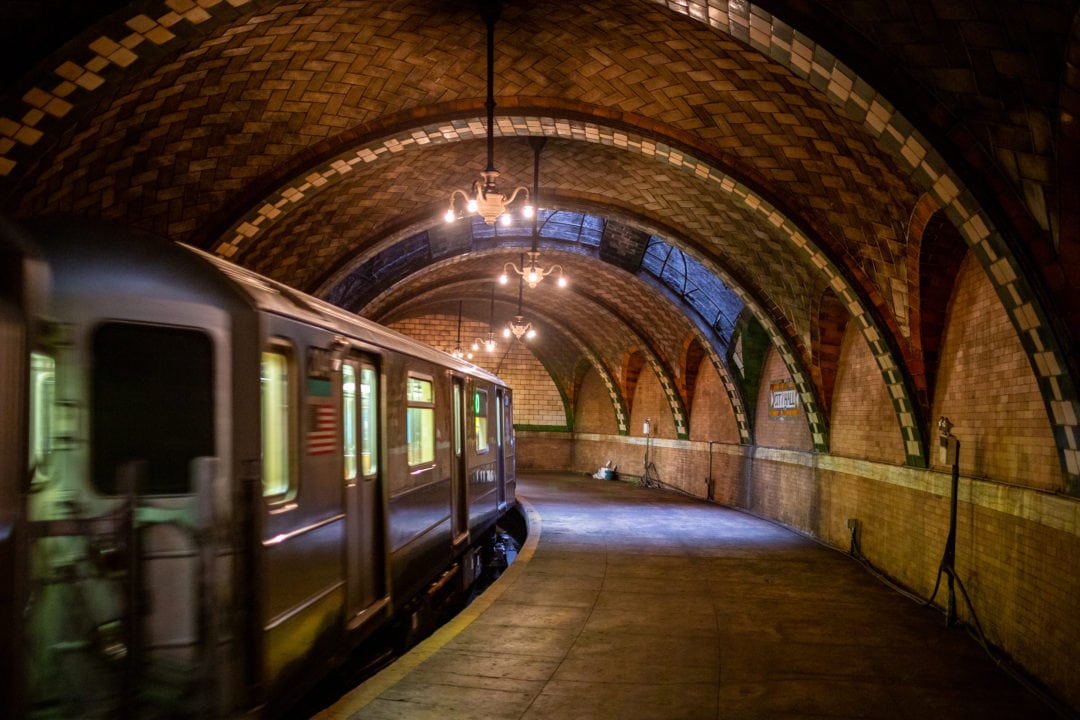
The photogenic space is not available to rent for events, weddings, or film shoots—but if you stay on the train after its last stop at Brooklyn Bridge, you can catch a glimpse of the station’s grandeur as the train loops around. However, if you want more time to take in the details (and non-blurry photos), your best bet is to take the two-hour tour.
“City Hall tours have been around since the Museum’s inception [in 1976],” Asborno says. “As part of the U.S. Bicentennial, NYCT celebrated the ingenuity of the subway system by opening up a temporary NYCT Transit Exhibit in the old Court Street Station and offering tours of the Old City Hall Station.”
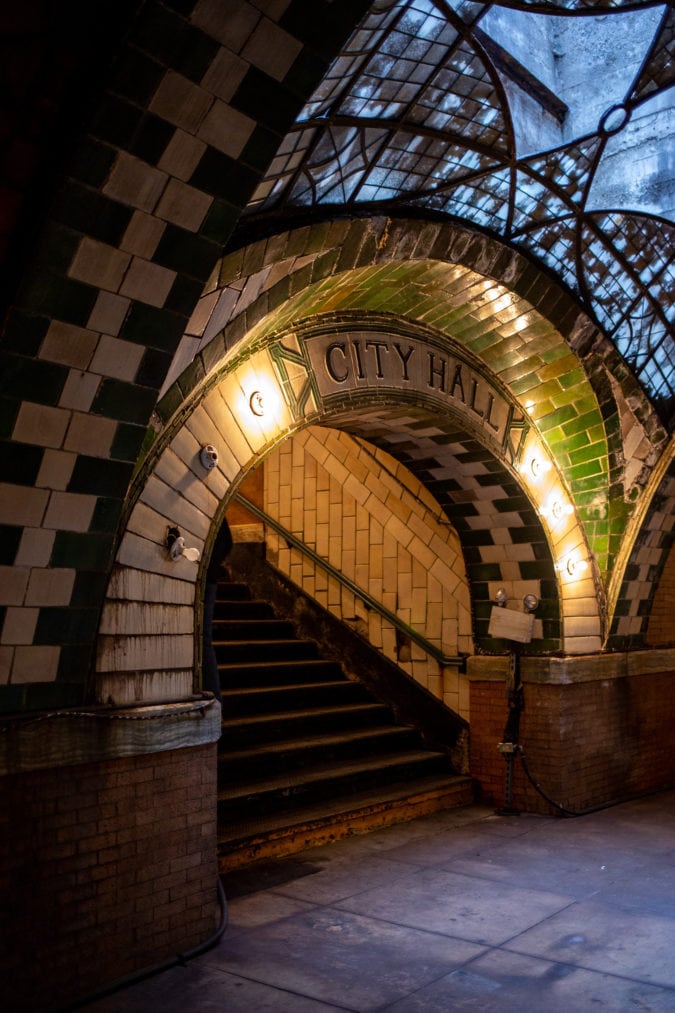
Although New York didn’t have the world’s first subway system (that was London) or even the first metro in the United States (Boston beat New York City by three years), it currently has the most stations of any system in the world. There are 472 individual stations spread across all five boroughs, but it all started with the sparkling, green and white tiled jewel beneath City Hall.
“I always say that it’s not the city that built the subway,” says Reeves. “It’s the subway that built the city.”
The next round of tickets will go on sale to members of the New York Transit Museum on April 17. You can become a member of the museum here . You can also see the old City Hall station anytime by staying on the No. 6 train at the Brooklyn Bridge station with the cost of a Metrocard swipe ($2.75).
Meet the Author

Roadtrippers
Roadtrippers helps you find the most epic destinations and detours—from roadside attractions to natural wonders and beyond.
- Related Articles
- Latest Articles

What’s the best roadside assistance?

Happy National Road Trip Day: Here’s where the Roadtrippers team has traveled
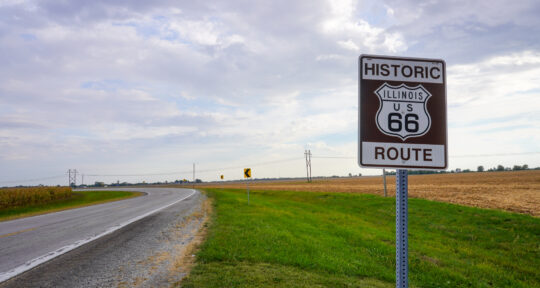
Route 66 goes electric: Meet the people and initiatives bringing the Mother Road into the future

Camping checklist for your next trip

What is glamping? Your guide to luxury in the outdoors

Unique ways to glamp: Airstreams, cabooses, teepees, and more
Get the most inspiring stories from the road sent directly to your inbox..

- Trip guides
- Trip Planner
- Sign up Log in Sign out
- Log in Sign out
- ROADTRIPPERS MEMBERSHIP
- RV RESOURCES
Plan your journey, find amazing places, and take fascinating detours with our app.
If you used to sign in with Roadpass, you should now use the same username and password to log in directly with Roadtrippers above.
We couldn't find an existing Roadtrippers account using that service. Please try signing in with another option.
We need your email address to send you trip itineraries and other updates.
How do you want to plan your trip?
With just a few questions, our newest Premium feature, Autopilot, will plan your next adventure.

There's an old, unused subway station underneath New York's City Hall. Here's what it's like to visit.
- New York has the oldest and most expansive subway system in North America.
- But the first ever underground station to open has long been shuttered since World War II.
- Today, the only way to get to the abandoned masterpiece is by special tour.

When New York City's subway first opened in 1904, it was a true modern marvel. Its very first station, almost directly beneath City Hall, was a sight to see. Sun flooded the platform from skylights in the ground above, and gilded chandeliers filled the shadows with electric light.
On the first day of service, some 15,000 New Yorkers would pay the nickel fare to ride the first subway to open outside of Europe.
But things wouldn't remain so glorious for this station. Once train cars became longer, the gaps between doors and platforms were deemed too wide to be safe. What's more, many passengers opted to walk from the larger Brooklyn Bridge station nearby, which had express service that the City Hall loop did not.
Today, there's no service provided to the station — trains made their final stop on December 31, 1945 — but you can catch a glimpse by riding a downtown 6 local train past its terminal stop, which today is known as Brooklyn Bridge-City Hall. Keep your eyes peeled as you go through the loop and a few minutes later you'll end up on the uptown platform of the same station.
If a mere glance isn't enough, the New York Transit Museum offers tours to members, and they sell out in just minutes. That's how Business Insider got the chance to visit. Here's what it's like:
As its name suggests, the subway station sits directly beneath City Hall, the oldest municipal headquarters in the United States. It's more than 200 years old.
The subway station was also beneath the City Hall Post Office and Courthouse Building, a massive French-style building that many derided as an eyesore. It was later demolished in 1939 to make way for what's today called City Hall Park.
The street cars on Park Row that crossed the Brooklyn Bridge (just out of view on the right) are long gone.
Here's how the tracks lie in relation to the City Hall building and the adjacent park. In this diagram it's easier to see how the 6 train makes its 180-degree turnaround while allowing express trains to continue south through downtown and into Brooklyn.
From above, it's nearly impossible to tell you're above a Gilded Age architectural marvel — but a trained eye could still see some of the skylights through the overgrown gardens in the park.
Unfortunately, both entrance stairways have been sealed as well, for security reasons, so we have to head over to the in-service platforms and get on a train that can let us off in the station.
We're doing this in the middle of rush-hour service, our tour guide reminds us, so we have to be quick when the train stops to let us off. Quickly after this train descends into darkness, our shuttle to decades past pulls in right behind it.
Those large gaps I mentioned earlier really are massive, and our tour guides bring over a ramp so we don't have to jump over live tracks.
Once on the platform, it really does feel like we've stepped back in time.
The hustle and bustle of trains just yards away is nearly silent. All of the street noise from above has been muffled. Dripping water, a near constant phenomenon in any subway station, is the only background noise to our tour guide's monologue.
A hard-to-read plaque commemorates the opening of "this first municipal rapid transit railroad of the City of New York"
This sign was impossible to see with the naked eye, but camera flash made it a bit better.
The station was designed by Rafael Guastavino — and it shows. The Spanish-born engineer is best-known for his arches, which can bee seen at other NYC landmarks like Grand Central Terminal and the Queensboro Bridge.
Guastavino was part of a larger movement known as City Beautiful, which flourished during the late 19th century and into the early 1900s. Many great buildings from the movement are landmarks in Chicago; Washington, DC; Cleveland; and Detroit.
Here's a closer look at the many layers of "Guastavino tiles" that make up a classic arch.
The skylights we saw from above are still functioning today — albeit with a few less tiles.
An even more elaborate skylight provided light for the original ticket hall.
The fare gates and ticket windows are long gone, but inside this vaulted room is where passengers would have paid their nickel to ride uptown to Grand Central Terminal, Times Square, and beyond.
Compared to some mega-stations, finding your way to the correct train was relatively simple here: just one staircase down to the platform!

If you noticed some people covering their ears in the previous photo, it's because trains that pass through the station during regular service are loud. Very loud.
Rail squeal occurs when train go through sharply curved portions of the track. You can also get a better sense of the platform gaps as this train passes through.
If this were a normal subway station, we'd be able to exit or enter through these stairways. Unfortunately all I found at the top was a padlocked door.
Overall, the station is in good shape, but it may never be returned to its former glory. Here's how it looked on a postcard at the time.
Tours aren't the only thing the Transit Museum does. It's one of the city's lesser known museums, but it has plenty of options for fans of historical transit.
Every winter, the museum runs a "shopper special" train on weekends to ring in the season.
You can read about the antique trains, courtesy of Business Insider's Ben Gilbert, here.
- Main content
- Skip to primary navigation
- Skip to main content
- Skip to primary sidebar
- Skip to footer
TravelAwaits
Our mission is to serve the 50+ traveler who's ready to cross a few items off their bucket list.
How To See New York’s Gorgeous Old City Hall Subway Station

Wikimedia Commons ( CC BY-SA 4.0 )
- Activities and Interests
- Architecture
- Destinations
- History and Culture
- New York City
- Sightseeing
- United States
Like the idea of touring old abandoned buildings? Well, what about an old abandoned subway station? If your answer’s yes, you’re in luck!
There is a chance you could see and maybe even tour what New York City Feelings refers to as “the most architecturally stunning subway station you’ve most likely never stepped foot in.” There are now a couple of ways to view New York’s Old City Hall subway station. Here’s how!

How To Tour New York’s Old City Hall Subway Station
So, how do you go about touring this abandoned subway station? It turns out there is one requirement: You must be a New York Transit Museum member. Due to there being a limited number of tour spots, the New York Transit Museum saves the opportunity for Transit Museum members only. The number of tickets you are allowed to purchase for the tour depends on your membership plan. After you’ve gotten past that, the only thing left to do is to pick a tour date and buy your tickets!
Tour dates can be found in the museum’s newsletter, which you can sign up to receive via email. Be mindful that the museum schedules tours and releases tickets only three times a year: January, April, and August. In January, tickets for tours taking place January through May will become available. In April, members can purchase tickets for tours taking place May through August. In August, members can purchase tickets for September, October, November, and December tours.

Buying tickets is fairly easy. Just create an account in the online ticketing system. If you’re already a New York Transit Museum member, then you will have an account. From there, you can sign in to buy tickets, which are $50 per person. Be quick! Tickets tend to sell out as soon as they go on sale — as in within 30 minutes fast.
Also heed this very important information: It is mandatory that you fill out a signed release form and provide a copy of your government-issued ID by the given deadline. Failure to do so will result in you not being admitted on the tour. There are no refunds on tickets.

Joe Wolf / Flickr
Another Way To Get A Peek At The Station
Maybe you’re not a New York Transit Museum member and are definitely not interested in becoming one just for the tour. There is still hope alive for you being able to view the abandoned station!
Although this won’t afford you a detailed view, according to Business Insider , “You can catch a glimpse by riding a downtown 6 local train past its terminal stop, which today is known as Brooklyn Bridge-City Hall. Keep your eyes peeled as you go through the loop and a few minutes later you’ll end up on the uptown platform of the same station.”
New York City Feelings suggests keeping a low profile while trying to catch a glimpse of the station. They say staying on the 6 train after its final stop isn’t technically legal due to safety and security concerns of the MTA.

“Stay on the train and duck down so as not to be easily spotted. When the train departs the station it will pass through the abandoned City Hall Station. That’s when you can get a view of the station.” They say you should “be discreet” and “keep in mind that staying on the train isn’t officially legal.” The good news? “It appears that MTA no longer strictly enforces the announcement that passengers leave the train at the Brooklyn Bridge station. Secretly visiting the station is somewhere in the ‘grey’ area of legality.”
Of course you can’t actually get off and tour the place as you would with a Transit Museum membership and tour tickets, but the ride will still afford you a pretty cool look at the abandoned station.

Salim Virji / Flickr
The Story Behind The City Hall Subway Station
Perhaps you’ve come across this article but still aren’t sure what the big fuss is about an old subway station. Don’t worry — here’s everything you need to know about the history of this abandoned station.
Designed by skilled architects Hein and LaFarge in 1904, New York City’s first subway ride departed from the City Hall station. The breathtaking station had vaulted tile ceilings created by master artisan Rafael Guastavino. The glamour of the subway was intensified by the station’s design.
According to the New York Transit Museum, “Its elegant chandeliers, leaded skylights, and graceful curves inspired awe among visitors.”

Felix Lipov / Shutterstock
The station started with a bang and on its first day serviced approximately 15,000 New Yorkers. People lined up to pay their nickel fare to take a ride on “the first subway to open outside of Europe,” according to Business Insider .
Not all things last, however, and the glamour of the station began to fade. The station posed a safety hazard due to the lengthening of train cars. As they got longer, gaps from the doors to the platforms were considered too wide to be safe. Also, the City Hall loop where the station was located didn’t have express service whereas the larger Brooklyn Bridge station nearby did. People began walking to the Brooklyn Bridge station instead.
The station’s tracks are still active and in use as a turnaround for the 6 line, but subways don’t stop at the Old City Hall station. In fact, trains made their last stop there on December 31, 1945.

A little fun fact: The old subway station had a moment in Fantastic Beasts and Where to Find Them , an installment of the Harry Potter movies. The station serves as the setting for a magical battle.
According to Rojak Daily , “The subway’s design was very timely with Fantastic Beasts’ setting, making it a perfect backdrop for the movie. This subway station was where two pivotal scenes in the movie took place — the epic battle between Credence, Graves, Scamander, and MACUSA, and also the mind-blowing moment when Colin Farrell transitioned into Johnny Depp.”
Maybe you’re a Harry Potter fan or maybe you just like charming old buildings with a ton of history. Either way, act on both of those interests by heading to the Old City Hall subway station.
Ready to take your quest for stunning (Potter-esque) architectural gems overseas? Set your sights on Porto, Portugal, and Livraria Lello, Portugal’s stunning bookshop .

Traneah is a college student interning with TravelAwaits as a content writer for the summer of 2019. She enjoys writing about various topics and writes on her own lifestyle blog, NaeIsMe , in her free time. She hopes to continue writing upon graduating with her English non-teaching degree from the University of Arkansas at Pine Bluff.
Tour Abandoned City Hall Station By Foot With This Guide
There are two ways to visit this old abandoned subway station, which was NYC's first subway station. One's a tour. The other's a bit more secretive!
Quick Links
The history of old city hall station in new york city, why did the old city hall station close, how to visit old city hall station in nyc, the new york transit museum old city hall station tour, where is the old city hall subway station, how to ride through old city hall station in new york city, what to know before visiting the old city hall station in nyc, when is the best time to visit the old city hall station in nyc.
From SUMMIT One Vanderbilt to the skyscraper museum in Manhattan , New York City offers its welcomed guests bountiful ways to enjoy its marvelous horizons and learn about its impressive history. Although many of the most popular attractions in NYC are above ground and out in the open air, some major landmarks are a little more unassuming and out of sight. Among the lesser-known historic sites in the Big Apple is one particularly special subway station that still stands — albeit as a ghost of its former self.
That station, echoing stories of the past, was the very first subway station in NYC. First opened on October 27, 1904, the grand, ornate City Hall subway station was the pièce de résistance of the shiny new NYC subway system; it became part of the city's first subway route and began operating for just over four decades until its closure in 1945.
For tens of years, it wasn’t possible to visit the abandoned station — an underground crypt containing New York City subway history and the very first of its kind. However, today, history hunters and urban Dora the Explorers can witness what was once New York City's grandest flagship subway station, with its majestic arches, vaulted ceilings, elegant Guastavino and colored glass tiling, opulent brass and wrought iron chandeliers, and intricate skylights — all sleeping peacefully under City Hall Park.
The pristine and beautiful hub interiors where old stories stagnate is among the best-hidden gems in NYC — one that remained in surprisingly good condition over the decades, despite the station's abandonment and disuse.
The Old City Hall Station history is a simple, age-old tale of the city's ever-evolving needs outgrowing what this subway hub was able to provide. Opening on October 27, 1904, the elaborately decorated station was the first subway in New York City and served as part of the network of trains operating under the urban sprawl.
The train line utilizing this station departed from its namesake City Hall and ventured north to Grand Central Terminal, rode through Times Square, and traveled on up to 145th Street. A simple yet iconic route that connected significant parts of the city commanded a very simple price; the fare to ride the subway was only five cents at the time — a time-worn shadow of today's rail prices.
Old City Hall Station's status as the first subway train, along with its important route, wasn't the sole reason it stood out. In fact, the architectural splendor and interior design truly earned the place a greater mark on the NYC map. Attention to detail in the decor department is seen throughout the intimate station.
Electric brass chandeliers, decorative plaques, intricate skylights, oak furnishings, white terra cotta, and beautiful tiling adorn the interiors, evoking the charm of old-world designs.
Beauty and traditional craftsmanship are seen structurally, too. The station's architects were George Lewis Heins and Christopher Grant LaFarge, who also designed the Cathedral of St. John the Divine. They employed numerous extraordinary design elements when piecing the station together; in particular, its lack of straight lines is noticeable.
Instead of conventional lines, the designers used curved entryways and vaulted ceilings, rendering the station visually stunning to the eyes.
The arched ceilings command just as much awe and were designed by the Gustavinos — a family that revolutionized architecture at the time with their patented vaulted tile ceiling techniques.
Incredibly, their works exist in more than 1,000 spaces across the United States, including 300 in New York City alone — one of which is the Whispering Gallery in Grand Central Terminal.
Though Old City Hall Subway Station served the city well for forty years, needs had changed. By the 1940s, the station failed to keep pace with the volume of passengers traveling along its lines, leading to the larger adjacent Brooklyn Bridge subway station gaining more popularity — especially among 'straphangers'.
City Hall’s old station was small and charming; however, it couldn't beat Brooklyn Bridge’s station — the latter whose platform could hold significantly more commuters and accommodate much longer trains. As quantity became more important than quality, City Hall Station passenger numbers fell, leading to its closure on December 31, 1945.
The station's life transporting the public may have come to an end, but it rightfully received interior landmark status in 1979 in recognition of its beauty and significance to the history and heritage of New York City.
There are two ways to visit the Old City Hall Station: on an official paid tour through the New York Transit Museum or alone free of charge from the windows of the 6 train heading downtown. The next sections of this guide will detail both options.
For the best experience, the guided tour option is advised, as the station is illuminated for paying guests while expert guides detail the history of the site.
However, these guided tours are only available for New York Transit Museum members to purchase. Tickets for the tour cost $50 per person and often sell out very quickly.
New York Transit Museum Old City Hall Station tours commence above ground and start with a leisurely historical walking tour of the area. After this initial exploration, tour participants are taken to the Old City Hall Station for an insider's look.
The tour lasts around 90 minutes and takes place no matter the weather. It also requires plenty of standing, walking, and stairs, so it may not be the best NYC tour for wheelchair users, people pushing strollers, and those with physical limitations.
There are also no restrooms on the tour, meaning guests are advised to go to the bathroom before the trip begins.
Guests are welcome to bring cameras and take photographs (especially since this part of the Big Apple features some of the best spots to take Instagram pictures in NYC ). However, big camera setups with tripods aren't permitted — only handheld devices.
According to the New York Transit Museum website, in-person guided tours of Old City Hall Station aren't always available. They only go on sale three times a year, and it's unclear if and when they will launch, so hopeful tour participants should check the museum's tour page regularly and look out for any updates.
Old City Hall Station rests under the Municipal Building of Centre Street and Chambers Street intersection. It can be seen right at the end of the 6 train line, which terminates at the Brooklyn Bridge/City Hall Station situated in Lower Manhattan.
Related: The Vessel: How To Visit New York's Stunning Architectural Overlook
The 6 train is bound for downtown, and when it comes back on itself to return uptown, it makes a U-turn loop through the secret and abandoned Old City Hall Station — enabling passengers to get a complimentary look in through the train's windows.
Despite being referred to as 'abandoned', the station does serve as a major part of the subway system — trains still screech along its tracks and head through every eight or so minutes, 24 hours a day.
Passengers can visit the NYC Old City Hall Station independently without a guided tour. Although, many people claim it's a bit of a gray area in terms of whether seeing the abandoned station this way is technically allowed. Still, many passengers do select this option, but they do so discreetly and respectfully.
According to numerous people who've done this route, they claim that the staff on board the train do seem to let folks stay on quietly and enjoy the ride through the old station, given its significant historical importance that makes many visitors wish to see it in person.
- Get on the 6 train heading downtown
- The train's final stop is the Brooklyn Bridge/City Hall station, where passengers may be told to exit the train. However, to get a glimpse of the abandoned station, they should stay on board
- Stay on the train. When it departs the Brooklyn Bridge/City Hall station, it passes through the old abandoned City Hall Station. When heading through, passengers can get a look at it, though they are advised to be quiet and respectful.
As the 6 train is a local train, some travelers coming from other parts of the city might be better off hopping on the 4 or 5 express trains to Brooklyn Bridge/City Hall Station and then getting on the 6 train at that station instead.
- Staying on the 6 train wasn't always allowed, and it's not entirely clear if it still is. However, the Metropolitan Transportation Authority (MTA) doesn't appear to enforce the 'rule' of passengers having to get off at Brooklyn Bridge station. Many passengers say that train conductors seem to 'ignore' people who wish to stay on to get a look at the Old City Hall Station. Still, it would be better (and more polite to staff) to ask first if it's okay to stay on to take a look
- If choosing the 'visit by oneself' option on the same day that the New York Transit Museum has a tour taking place, make sure to avoid the first car of the train — that's for paying tour guests only
- The station isn't too far from some of the best foodie neighborhoods in NYC , so grabbing some grub afterward is a well-deserved treat!
The best time to visit NYC's Old City Hall Subway Station is on a clear, bright sunny day when the skylights in the ceilings naturally light up the interiors. Also, for the best possible experience, opting for the New York Transit Museum's members-only tour of the station is unbeatable.
When the museum's tours are taking place, the station's gorgeous chandeliers are switched on for paying tour participants, who get to right in the first car of the train.
Related: Tips For Tourists On The New York City Subway For The First Time
Whether wondering how to spend a weekend in NYC or a longer city break for a week or two, checking out the Big Apple's lesser-known, hidden historic gems affords a more intimate, private experience getting to know this metropolis's illustrious history.
It also introduces visitors to the people who built it from the sidewalk up (and from beneath the concrete, too — the city's old tales go much deeper than the paved streets).
[WATCH] Take a Virtual Tour of New York City's City Hall Subway Station
Welcome to the second installment of transit tours! Today I've gone down to Lower Manhattan to document the unique City Hall station, which has many surprises to be found.
Note this is a tour of the modern station. Check out any of our posts on the abandoned station next.
via Station to Station
- subway stations
Matt Coneybeare
Editor in Chief
Matt enjoys exploring the City's with his partner and son. He is an avid marathon runner, and spends most of his time eating, running, and working on cool stuff.
Posts by Matt Coneybeare
Something wrong with this post? Let us know!
Share This Post
If you liked this, you may enjoy….

Subscribe to Viewing NYC by Email
We hate spam too, so we absolutely won't give your email address to anybody else. Expect emails containing the site's most popular articles only as frequently as you like.
Brought To You By…
Stay connected, what is viewing nyc.
Viewing NYC is a site that features videos and photos of the art, comedy, culture, food, history and events of New York City.
Random Post

Most Popular Posts This Week

Recent Posts on Twitter
This website uses cookies to improve your browsing experience and analyze the use of the website. Learn More
Reserve Your Spot with Confidence! Full Refunds with 24 Hrs Notice. Reschedule at any point, even after tour, if space allows!

New York City Hall Tours

This post is about taking a tour of New York's City Hall and includes information about tickets, directions, what you will see there, and nearby attractions.
- Introduction
- How to Get Here
- Guided Tours
- Things to Do in the Area
- Free Things to do in NYC
- Other Attractions in NYC
INTRODUCTION
New York’s City Hall, located in Lower Manhattan, is the country’s oldest city hall that is still used for its original purpose.
While most of the city government offices are now housed in the big, magnificent Municipal Building across the street, the Mayor and the City Council still work about of City Hall.
Given the long and sometimes tumultuous history that took place in City Hall, tours are offered to the public for free. (For more history, see below ).
Taking a City Hall free tour makes for a great inclusion in your sightseeing in Lower Manhattan.
Besides City Hall, there are many more iconic attractions to see in Lower Manhattan. Check out our long list of attractions in NYC .
Tip: Consider joining our pay-what-you-like Lower Manhattan tours before or after a City Hall tour.
HOW TO GET HERE
As you can see on the map, there are multiple subway stations surrounding City Hall.
You can use this link to Google Maps to get exact directions from your departure point.
- City Hall (N/R lines)
- Park Place (2/3 lines)
- Brooklyn Bridge-City Hall (4/5/6 and J/Z lines)
- Chambers St (1/2/3 and the A/C lines)
- World Trade Center (E line)
- Fulton Street Station (2/3, A/C/ and 4/5 lines)
You might find our post on navigating the NYC Subway helpful.
By bus: M103, M20, M55. Also most Hop-on, Hop-off buses stop near City Hall.
FREE CITY HALL TOURS
Tours are held on Wednesdays at 12 pm and Thursdays at 10 am (subject to change for any special events at City Hall).
To take this free tour you must make a reservation .
As tours are limited to 20 people, we recommend that you make reservations as soon as possible.
Click here to make a reservation . On the tour, you will see the historic and beautiful rotunda, the City Council chamber, and Governor's Room, a reception room that houses part of the City Hall Portrait Collection and historic furnishings.
Some things to note:
- All tours are one hour long. You will be walking and standing for this period of time.
- The recommended minimum age for guests is 9 years old.
- You will be required to go through a security checkpoint.
- Bring a photo ID with you.
TIP: In addition to a free City Hall tour, there are lots of things to do in NYC that won't cost you a dime. See our post on free things to do in NYC for more ideas.
THINGS TO DO NEARBY
City Hall is located in the heart of Lower Manhattan, an area that has countless things to do, day and night.
Below we list just a few of our favorite Lower Manhattan activities.
Take a sightseeing tour of Lower Manhattan and learn about its rich history, its architecture, and more.
Visit the 9/11 Memorial which is located a few blocks away from City Hall and is free to visit. Go to the top of One World Observatory (“Freedom Tower”) for jaw-dropping views of New York City.
Take a free ride on the Staten Island Ferry for fantastic views of the NYC skyline.
Last but not least, walk over the Brooklyn Bridge - the entrance to the pedestrian path is located just across the street from Cty Hall!
We offer both day and night pay-what-you-wish walking tours of the Brooklyn Bridge and also have a GPS-enabled audio tour that you can use any time of the day or night.
To find out about all the great things to do in Lower Manhattan, including free, family-friendly, and nighttime activities, see our in-depth post on things to see in Lower Manhattan .
The present-day City Hall is actually the third one in the city’s history.
In the Dutch colonial era (when the city was called New Amsterdam), the city hall was called Stadt Huys (State House, in Dutch) and was located on Pearl Street in a former tavern.
The city government operations then moved to a new home on Wall Street in 1700, where they would remain for the rest of the British colonial era.
The Wall Street building also served as the first United States Capitol Building for New York’s brief period as the US capital city. It resumed functions as City Hall when the capital was moved to Philadelphia and continued as such until the present building was opened in 1812.
Plans for the current City Hall began in 1802 when the city had a design competition for the future building.
The competition was won by the design team of Joseph Francois Mangin and John McCombs Jr. Mangin, the principal designer.
McCombs was the architect of Old St. Patrick’s Cathedral in Little Italy . He also designed Castle Clinton in Battery Park . You can see both these buildings still.

This was due in part to objections from the City Council, saying that the design was too extravagant and costly.
The architects re-worked the design, making the building smaller, and reducing the amount of marble used.
They decided to only have the façade done in marble and to use cheaper brownstone on the back.
The site for the City Hall was at the far northern edge of the present city, so they reasoned that not many people would see the back anyway.
Midway through construction, in 1811, the City Commissioners unveiled the grid plan for Manhattan, which quickly moved the city northward.
The mismatched back and front of the building were not remedied until 1954 when the entire building was refaced with Alabama limestone.
Back to top
Related posts:
- Free Things to Do in NYC
- NYC Attractions
- Things to Do in Lower Manhattan
By Katherine Weatherford
Choose a Destination... I want them all PLUS general travel tips. Amsterdam Berlin Boston Charleston Chicago Dubai Lisbon London Los Angeles Miami Nashville New York City New Orleans Paris Philadelphia Prague Rome San Francisco Washington DC
About The Author

Courtney Shapiro
North america, united kingdom & ireland, middle east & india, asia & oceania.

- Reservations

City Hall Tours
Learn more about City Hall with our online exhibit that highlights the landmarked rotunda , City Council Chamber , and Governor's Room , a reception room that houses part of the City Hall Portrait Collection and historic furnishings.
One of the oldest continuously used City Halls in the nation that still houses its original governmental functions, New York's City Hall is considered one of the finest architectural achievements of its period. Constructed from 1803 to 1812, the building was an early expression of the City's cosmopolitanism. City Hall is a designated New York City landmark, and its rotunda is a designated interior landmark as well.
Reservation tours of City Hall are offered every week. Tours are limited to 20 individuals and reservations must be made in advance. The next tour date is listed below.
Group Tours:
- Tuesday, June 4 at 10:30 a.m.
- Tuesday, June 11 at 10:30 a.m.
- Tuesday, June 18 at 10:30 a.m. RESERVED
- Tuesday, June 25 at 10:30 a.m.
Individuals Tours:
- Wednesday, June 5 at 12:00 p.m. CANCELLED
- Wednesday, June 12 at 12:00 p.m.
- Thursday, June 13 at 10:00 a.m.
- Thursday, June 20 at 10:00 a.m.
- Wednesday, June 26 at 12:00 p.m.
Make a reservation.

Shop uniquely New York tees, hats, jewelry, masks and more at the New York Transit Museum Store.
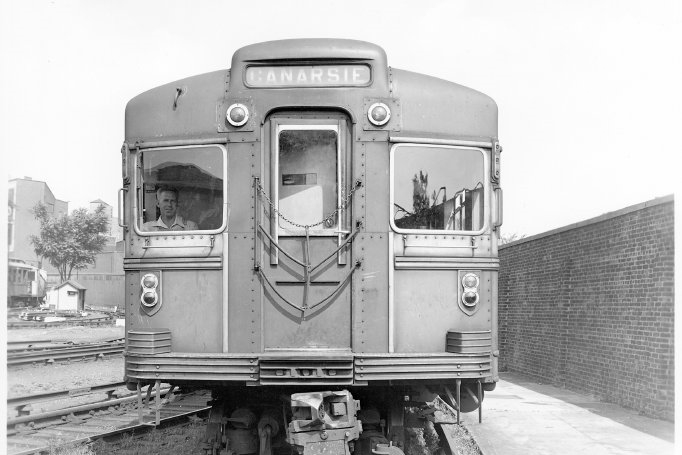
UPCOMING PROGRAMS
View our calendar of upcoming programs including virtual offerings, tours and excursions, member events, and more.
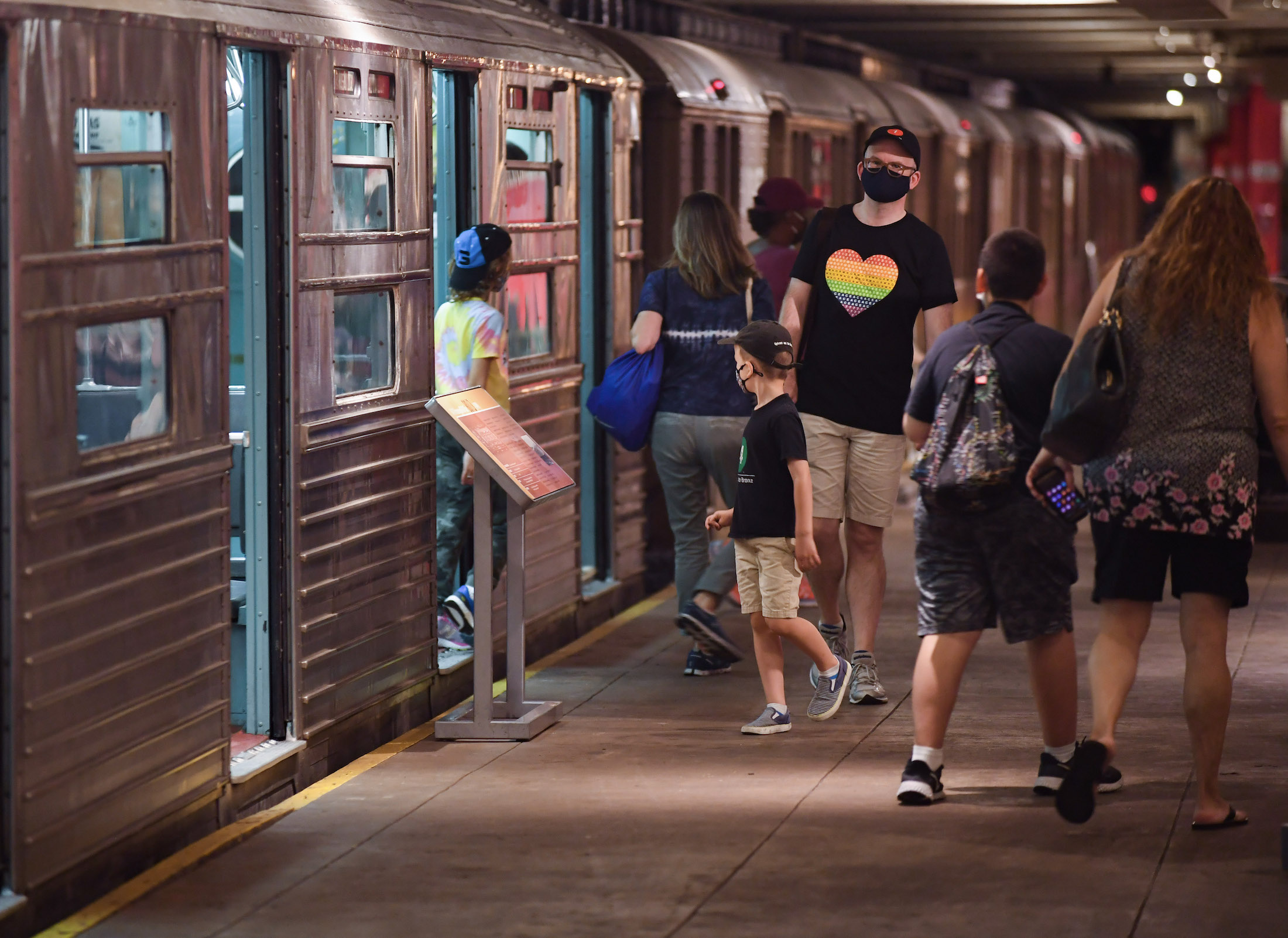
BECOME A MEMBER
Join, renew, or gift a membership to support the Museum’s recovery and enjoy exclusive benefits!
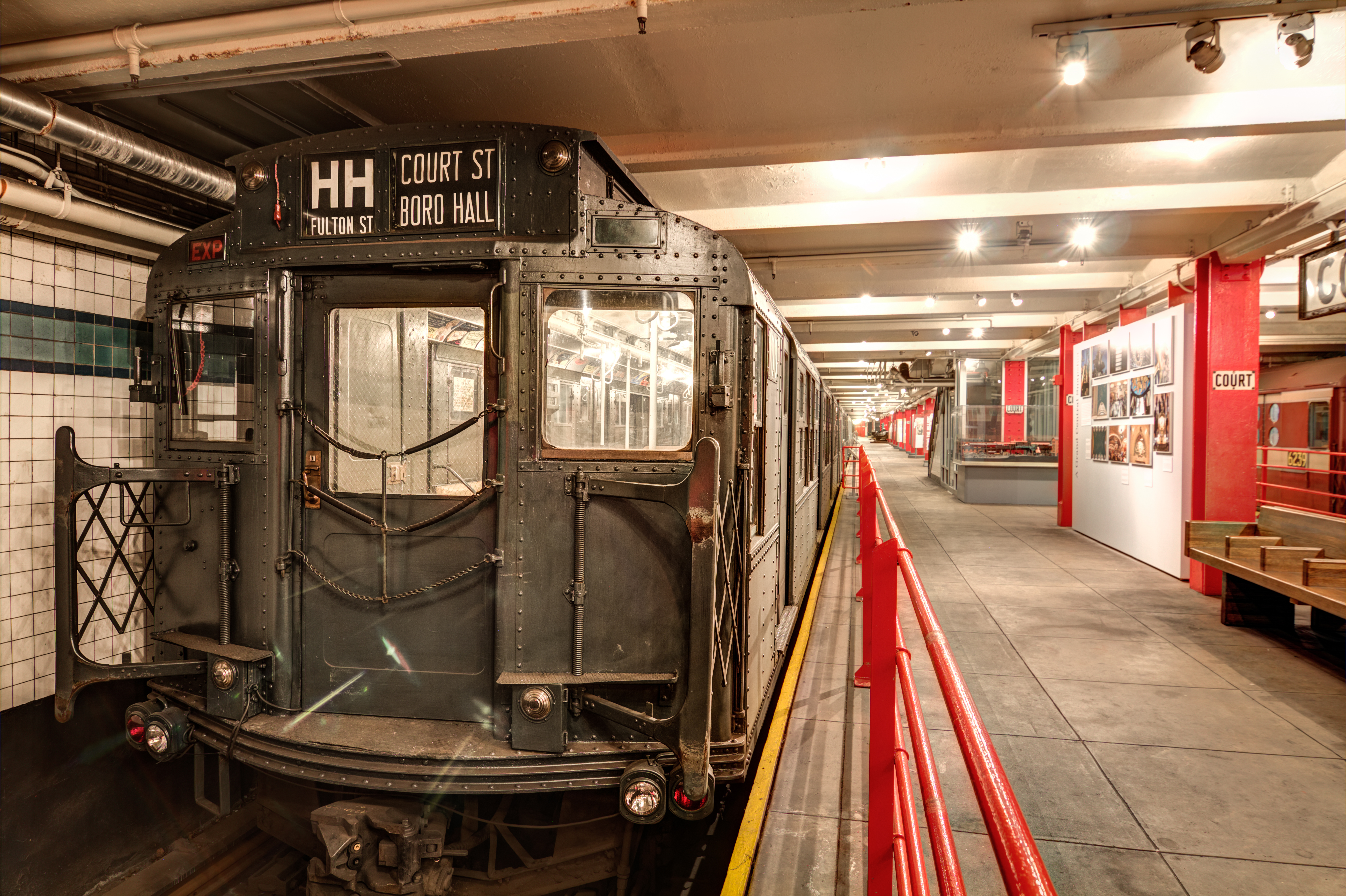
MAKE A GIFT
Support the New York Transit Museum! Your entirely tax-deductible contribution will enable the Transit Museum to continue creating innovative exhibits, accessible education programs, and unforgettable experiences.
TRANSIT MUSEUM DOWNTOWN BROOKLYN
Open Thursday – Sunday 10am to 4pm
GALLERY & STORE AT GRAND CENTRAL
Monday – Friday, 10am – 7:30pm Saturday & Sunday, 10am – 6pm
SHOP AT 2 BROADWAY
Open Tuesday – Thursday 10am to 4pm
ABOUT THE MUSEUM
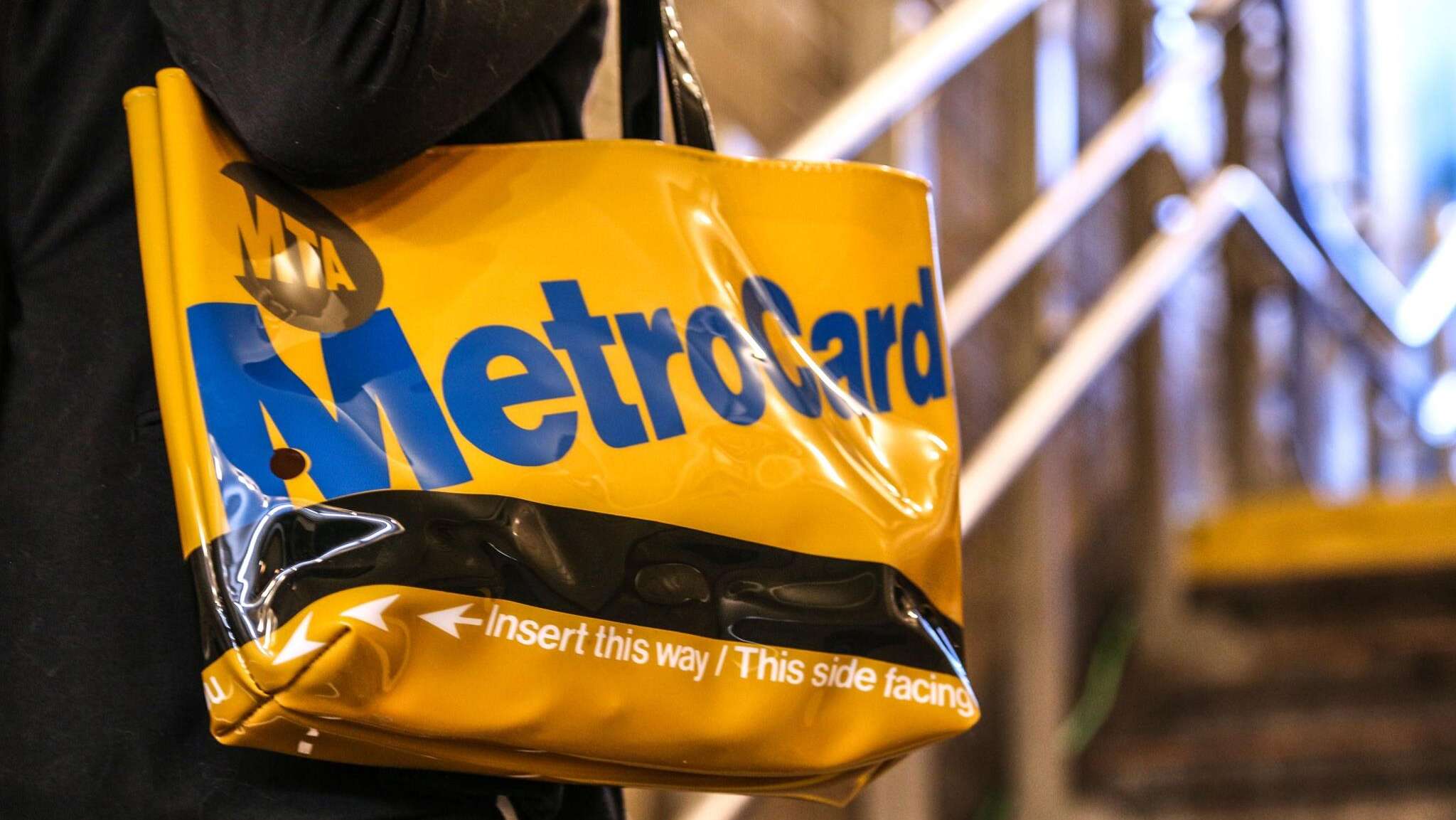
Michigan Central Station reopening: Everything you need to know
Michigan central station reopens june 6 with an epic concert, followed by public tours all summer long and a 'phased reactivation.' let's catch you up on the historic train depot's revitalization..
Michigan Central Station reopens Thursday, June 6, 2024.
Starting that day, for the first time in person, the public will get a chance to see inside the six-year renovation of the historic building , which sat abandoned for decades after the Corktown train depot's closing in 1988. Ford purchased the station in 2018 from the Moroun family.
The Free Press got a peek inside the Michigan Central Station in recent weeks. Here's everything we saw, plus what to know on the reopening concert , tours and more.
What is Michigan Central Station?
Michigan Central Station opened in 1913 in Detroit's Corktown neighborhood as one of the country’s most spectacular transportation terminals. It saw 4,000 daily passengers at its peak, but, following decades of declining rail travel, was shuttered in 1988 and sat vacant for three decades.
Ford Motor Co. bought the decaying building in 2018 and spent the next six years renovating it.
Michigan Central Station photos
Here's what Michigan Central Station looks like inside .
The before-and-after photos give you a clear picture of what the train station looked like during its early days and abandoned years, and how it compares to after the $950-million renovation. Here's a look .
When is the Michigan Central Station concert?
A free concert will celebrate the train depot's rebirth, featuring a lineup of well-known Detroit artists. It will be held at 8:30 p.m. Thursday in Roosevelt Park in front of Michigan Central Station.
The 90-minute show is part of an 11-day series of first-look events dubbed “Michigan Central OPEN." The space will accommodate 15,000 concertgoers.
Who are the Michigan Central Station concert performers?
A blockbuster, all-star celebration of Detroit music will bring Diana Ross, Jack White, Big Sean and a host of other top names to the restored Michigan Central train station.
Eminem and his manager, Paul Rosenberg, are billed as executive producers of the Thursday night show. The concert is spearheaded by Ford Motor Co., which spent nearly $1 billion to renovate the site and unveiled the artist roster Monday morning after weeks of buildup.
Other performers include hip-hop duo Slum Village , gospel stars Kierra Sheard and the Clark Sisters , techno-house DJ Theo Parrish and the Detroit Symphony Orchestra . The show will also feature visiting artists such as Jelly Roll , Fantasia , Common and Melissa Etheridge performing tributes to the city’s rich music heritage.
Branded as “Live From Detroit: The Concert at Michigan Central,” the event will stream live on Peacock, then air Sunday on NBC as a prime-time special.
Here's more from Brian McCollum.
How can I watch the Michigan Central Station concert elsewhere?
The Downtown Detroit Partnership (DDP) will host watch parties at the following parks:
- Campus Martius Park, 800 Woodward Ave., with capacity for 5,000 people.
- The Corner Ballpark at 1680 Michigan Ave., with capacity for 2,500 people.
Local businesses will also host watch parties, including:
- Alpino Detroit - Michigan Central Opening Reception Hour at 1426 Bagley St.
- Armando’s Mexican Restaurant - MC Open Watch Party at 4242 Vernor Hwy.
- La Jalisciense Supermercado & Taqueria at 3923 Vernor Hwy.
- Mexican Town Bakery at 4300 Vernor Hwy.
- Batch Brewing Company at 1400 Porter St.
- Black Ginger (Housed within the Trumbull and Porter Hotel) at 1331 Trumbull STE 100.
- McShane’s Irish Pub at 1460 Michigan Ave.
- Mercury Burger Bar at 2163 Michigan Ave.
- Momento Gelato and Coffee at 2120 Trumbull.
- Slows BBQ at 2138 Michigan Ave.
When are the Michigan Central Station tours?
Free public tours of the Michigan Central Station begin Friday, June 7, and continue through Sunday, June 16 . Registration for these tours is sold out. These "OPEN Houses" from June 7-16 will allow visitors to experience the grandeur of the restored station through an "immersive" tour. Visitors can expect to explore various activations, storytelling and art throughout the ground floor of the train station.
In addition, OPEN Outdoors will take place outside of the train station on the front lawn of the renovated Book Depository building, now known as Newlab.
After June 16, the first floor will be open for tours on Fridays and Saturdays through the summer. Expanded hours will later be announced for the fall, when the first phase of commercial activations opens to the public, according to a news release.
Here's more .
How do I get to Michigan Central Station?
Major events can drive plenty of traffic in the Corktown area. Several roads will close throughout the reopening event, but visitors can choose from nearby street parking, free parking in the 1501 Wabash St. garage on a first-come, first-served basis, riding the bus through the Detroit Department of Transportation, e-scooters or ridesharing.
What's next for Michigan Central Station after reopening?
After reopening festivities, Michigan Central will begin a "phased reactivation" of the train station for several months as restaurant, retail and other commercial and community-focused partners fill the space.
Follow the Detroit Free Press on Instagram ( @detroitfreepress ), TikTok ( @detroitfreepress ), YouTube ( @DetroitFreePress ), Twitter/X ( @freep ), and LinkedIn , and like us on Facebook ( @detroitfreepress ).
Stay connected and stay informed. Become a subscriber .

IMAGES
VIDEO
COMMENTS
Tours last approximately 90 minutes. Though its track is still active as a turnaround for the 6 line, trains no longer stop at Old City Hall station. New York Transit Museum members have the unique opportunity to explore this New York landmark through exclusive guided tours. Tickets cost $50 per person.
City Hall Station passenger numbers dwindled and the station was closed to the public on December 31, 1945. Recognizing its beauty and its significance to New York City's history, the station was granted interior landmark status in 1979. Tip: Anytime you are riding the subway be on the lookout for great musicians, buskers, and performers.
November 19, 2023. The City Hall Subway Station is one of New York's must stunning underground treasures, and it has been closed to the public since 1945. Actually visiting the abandoned City Hall Subway Station in New York is only permitted through tours organized by the New York Transit Museum, and the ticket for these tours is so prized ...
Tours of the Station. Public tours have been offered by the New York Transit Museum about 16 times a year. Tickets cost $50 per person and sell out very quickly. If you want to experience the City Hall station, your best bet is to get a Transit Museum membership, which costs between $35 and $50 a year.
Returning to the museum are tours of the old City Hall subway station, the first-ever station of the New York City subway. Opened in 1904, it was intended to be the pièce de résistance of the entire transit system. The tour begins above ground to discuss Alfred Beach's Pneumatic Tube, before traveling deep underground to uncover all the ...
After a three-year pandemic hiatus, in-person tours of New York City's abandoned City Hall subway station are returning this spring. The station, which is where the first ever subway ride departed ...
The old City Hall station as it looks today. | Photo: Alexandra Charitan. Today the old City Hall station—closed since 1945—is popular with urban explorers. If you want to avoid a criminal trespass charge, you can take a sanctioned tour, available only to members of the New York Transit Museum. But be warned: Tickets only go on sale three ...
Jewel in the Crown: Old City Hall Station Tour. Tuesday, April 25th, 2023. 11:00 AM ET. Members Only. In 1904, New York City's very first subway ride left from the City Hall Station amidst great civic pride. With exclusive access through the New York Transit Museum, explore the elegant chandeliers, leaded skylights, vaulted tile ceiling, and ...
Discover Old City Hall Station in New York, New York: A beautiful and abandoned New York subway station from 1904, complete with chandelier.
Advertisement. When New York City's subway first opened in 1904, it was a true modern marvel. Its very first station, almost directly beneath City Hall, was a sight to see. Sun flooded the ...
Designed by skilled architects Hein and LaFarge in 1904, New York City's first subway ride departed from the City Hall station. The breathtaking station had vaulted tile ceilings created by master artisan Rafael Guastavino. The glamour of the subway was intensified by the station's design. According to the New York Transit Museum, "Its ...
New York Transit Museum Old City Hall Station tours commence above ground and start with a leisurely historical walking tour of the area. After this initial exploration, tour participants are taken to the Old City Hall Station for an insider's look. The tour lasts around 90 minutes and takes place no matter the weather.
by Matt Coneybeare at 12:00 PM on February 17, 2021. Welcome to the second installment of transit tours! Today I've gone down to Lower Manhattan to document the unique City Hall station, which has many surprises to be found. Note this is a tour of the modern station. Check out any of our posts on the abandoned station next. via Station to Station.
Jewel in the Crown: Old City Hall Station Tour. Saturday, June 24th, 2023. 2:00 PM ET. Members Only. Off-site Program. Sold Out. In 1904, New York City's very first subway ride left from the City Hall Station amidst great civic pride. With exclusive access through the New York Transit Museum, explore the elegant chandeliers, leaded skylights ...
The City Hall subway station was the grandest of them all. Located under Manhattan's City Hall, and designed by NYC architects Heins & LaFarge and Valencian architect Rafael Guastavino, the station was one of the most impressive ones built. Wikimedia Commons The view of City Hall station in the early 1900s. Paying tribute to Romanesque ...
One of the most coveted locations urban explorers hope to get the chance to visit is the mythical City Hall Subway Station.New York City's very first subway stop, though now abandoned, has gone ...
New York City Hall Tours are free to take, but you need to make a reservation well in advance. Learn how to do so on our blog post. ... Fulton Street Station (2/3, A/C/ and 4/5 lines) You might find our post on navigating the NYC Subway helpful. By bus: M103, M20, M55.
After a three-year pandemic hiatus, in-person tours of New York City's abandoned City Hall subway station are returning this spring. The station, which is where the first ever subway ride ...
City Hall is a designated New York City landmark, and its rotunda is a designated interior landmark as well. Reservation tours of City Hall are offered every week. Tours are limited to 20 individuals and reservations must be made in advance. The next tour date is listed below. Group Tours: Tuesday, May 21 at 10:30 a.m.
Zach Bryan kicked off his 2024 Quittin' Time Tour on March 6 at the United Center in Chicago. He is heading to Pittsburgh, Buffalo and Toronto, among other tour stops. Fans of the country artist can also catch him at a number of festivals in 2024, like Buckeye Country Superfest and Bourbon and Beyond Festival.
The New York Transit Museum is a unique museum devoted to the impact of public transportation on the growth and development of the New York metropolitan region. ... Old City Hall Station; Exhibits & Collections. ... tours and excursions, member events, and more. LEARN MORE.
Here's what Michigan Central Station looks like inside.. The before-and-after photos give you a clear picture of what the train station looked like during its early days and abandoned years, and ...